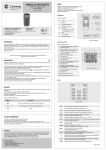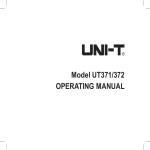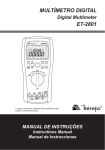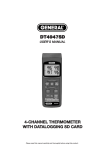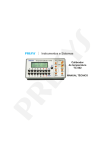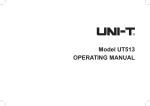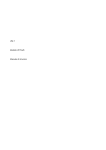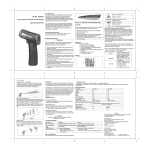Download Uni-Trend UT325
Transcript
Model UT321/322/323/325: OPERATING MANUAL Table of Contents Title Safety Information Getting Started Components Display Elements Buttons Using the Thermometer Changing Setup Options Entering and Exiting Setup Changing the Logging Interval Changing the Thermocouple Type Changing the Offset (T1) Changing the Offset (T2) Sleep Mode Changing the Line Frequency Setting the Time Setting the Low Limit Alarm (Lo) Setting the High Limit Alarm (Hi) Page 4 7 8 10 12 16 16 17 17 18 18 18 19 19 19 20 21 1 Model UT321/322/323/325: OPERATING MANUAL Title Enabling or Disabling Over Limit Signal Output Enabling or Disabling Normal Temperature Compensation (NTC) Enabling or Disabling Debug Measuring Temperatures Connecting a Thermocouple Displaying Temperatures Holding the Displayed Temperatures Turning on and off of display backlight Viewing the MIN, MAX, and AVG Readings Using the Offset to Adjust Probe Errors Over Limit Alarm Over Limit Signal Output Debug Using Memory Starting and Stopping Logging Viewing Logged Readings Clearing Memory Communicating with a PC 2 Page 23 23 24 25 25 26 26 26 26 27 27 27 28 29 29 30 31 31 Model UT321/322/323/325: OPERATING MANUAL Title Maintenance Replacing the Battery Cleaning the Case Specifications Environmental General Electrical Page 32 32 32 33 33 33 33 3 Model UT321/322/323/325: OPERATING MANUAL Safety Information The Uni-Trend Model UT321, UT322, UT323 and UT325 Thermometers (‘the thermometer) are microprocessor-based, digital thermometers designed to use external J-, K-, T-, E-, R-, S- and N- type thermocouples (temperature probes) as temperature sensors. UT321: T1, suitable for K-, J-, T- and E- type thermocouples UT322: T1 and T2, suitable for K-, J-, T- and E- type thermocouples UT323: T1, suitable for K-, J-, T-, E-, R-, S- and N- type thermocouples. Equipped with over limit alarm, over limit signal output and user self-debug features. UT325: T1 and T2, suitable for K-, J-, T-, E-, R-, S- and N- type thermocouples. Equipped with over limit alarm, over limit signal output and user self-debug features. Use the thermometer only as specified in this manual. Otherwise, the protection provided by the meter may be impaired. 4 Model UT321/322/323/325: OPERATING MANUAL Refer to safety information in Table 1 and the international symbols in Table 2. Table 1. Safety Information Warning A warning identified conditions and actions that pose hazards to the user. To avoid electrical shock or personal injury, follow these guidelines: Before using the thermometer inspect the case. Do not use the thermometer if it appears damaged. Look for cracks or missing plastic. Pay particular attention to the insulation around the connectors. Disconnect the thermocouple(s) from the thermometer before opening the case. Replace the batteries as soon as the battery indicator ( ) appears. The possibility of false readings can lead to personal injury. Do not use the thermometer if it operates abnormally. Protection may be impaired. When in doubt, have the thermometer serviced. Do not operate the thermometer around explosive gas, vapor, or dust. Do not apply more than the rated voltage, as marked on the thermometer (30V|), between the thermocouple(s), or between any thermocouple and earth ground. When potential differences are anticipated between the thermocouples, use electrically insulated thermocouples. When servicing the thermometer, use only specified replacement parts. Do not use the thermometer with any part of the case or cover removed. 5 Model UT321/322/323/325: OPERATING MANUAL Caution A caution identifies conditions and actions that may damage the meter or the equipment under test. Use the proper thermocouples, function, and the range of your thermometer. When carrying two thermocouples measurement, make sure there are no potential differences between two thermocouples. Do not attempt to recharge the battery. Match the + and – polarities of the battery with the battery case. Table 2. International Symbols Refer to the manual for information about this feature Complies with European Union directives Battery 6 Model UT321/322/323/325: OPERATING MANUAL Getting Started Everything in this Users Manual applies to all Models of UT321, UT322, UT323 and UT325 unless otherwise indicated. To become familiar with the thermometer, study the following: Figure 1 and Table 3 describe the components Figure 2 and Table 4 describe the display. Figure 3-a and 3-b and Table 5 describes the functions of the buttons. Then read the following sections. 7 Model UT321/322/323/325: OPERATING MANUAL Figure 1. Components 8 Model UT321/322/323/325: OPERATING MANUAL Table 3. Components 1 Display 2 Buttons 3 Thermocouple T1 input 4 Thermocouple T2 input (UT323 and UT325 only) 5 USB Port 6 SIGN Port - Over Limit Signal Output (UT323 and UT325 only) 7 NTC 8 Battery Door 9 9V battery (6F22 ) 9 Model UT321/322/323/325: OPERATING MANUAL 10 Model UT321/322/323/325: OPERATING MANUAL Table 4. Display Elements 1 2 3 4 5 6 7 8 9 10 11 12 13 14 Setup is in progress when the icon blinks Display readings of maximum, minimum and average Data Transferring is in progress Logged readings are displayed when the icon blinks Low battery. Replace the battery The thermocouple type The temperature units Secondary Display 1 Under Calibration mode when the icon blinks. The displayed reading is fixed. Secondary Display 2 The thermocouple measurement includes an offset. See “Changing Setup Options” Readings are being logged when the icon blinks Primary Display The displayed readings do not change The symbol of display backlight 11 Model UT321/322/323/325: OPERATING MANUAL Figure 3-a UT321 and UT323 buttons set 12 Model UT321/322/323/325: OPERATING MANUAL Figure 3-b UT322 and UT325 button set 13 Model UT321/322/323/325: OPERATING MANUAL Table 5. Buttons HOLD ºC ºF Press to turn the thermometer on or off Press to turn the display backlight on and off. Press to freeze or unfreeze the displayed readings Press to switch between Celsius (ºC), Fahrenheit(ºF), and Kelvin (K) MAX MIN Press to step through the maximum, minimum, and average readings. Press and hold to turn off this display. Press to step through K-, J-, T-, E- (R-, S-, N-) type thermocouple. Press to toggle showing the T1, T2 and T1-T2 (differential temperature measurement) in the primary or secondary display 1 SEND STORE Press to enter USB mode and the USB icon blinks. Press again to exit USB mode. Press to start or stop logging. (See “Using Memory - Starting and Stopping Logging”.) Press to show logged readings RECALL Press again to stop. 14 Model UT321/322/323/325: OPERATING MANUAL Table 5. Buttons SETUP ENTER Press to start or exit Setup. Press to scroll the Setup option you want to change (See “Changing Setup Options”) After entering the Setup mode, press to increase the displayed setting. (See “Changing Setup Options”) After entering the Setup mode, press to decrease the displayed setting. (See “Changing Setup Options”) Confirm button. (See “Changing Setup Options”) 15 Model UT321/322/323/325: OPERATING MANUAL Using the Thermometer 1) Plug the thermocouple(s) into the input connector(s). 2) Press the power button to turn on the thermometer. 3) Set the type of thermocouple(s) to be same of the type plug into the input connector(s). If no thermocouple is plugged into the selected input or the thermocouple is “open” and the over-range positive deviation is too big, the display shows “_ _ _ _“. Changing Setup Options Use Setup to change the following settings: Logging interval Thermocouple type Offset (T1) Offset (T2) (UT322 and UT325 only) Sleep Mode Line Frequency Time (S-T) Low Limit Alarm (Lo) (UT323 and UT325 only) High Limit Alarm (Hi) (UT323 and UT325 only) Over Limit Signal Output (SI) ON/OFF (UT323 and UT325 only) Normal Temperature Compensation (NTC) ON/OFF DEBUG ON/OFF (UT323 and UT325 only) Save setting and return to normal measurement mode. 16 Model UT321/322/323/325: OPERATING MANUAL When the thermometer is in Setup mode, the display shows and blinks SETUP. Press SETUP to start or exit Setup. Press SETUP to scroll the Setup option you want to change after The logging interval determines how often the thermocouple stores logged readings in memory. You choose the length of the logging interval. See “Using Memory”. Press SETUP until the display shows INTERVAL. The thermometer stores logged readings at the end of each logging interval. You can select a logging interval by pressing or . Holding down or causes the number to change more quickly. The maximum interval is 59:59 and the minimum interval is 00:00. When the logging interval is 00.00, you need to store the readings manually as the auto store feature will be disabled. 17 Model UT321/322/323/325: OPERATING MANUAL 1. Press SETUP until the display shows TYPE. 2. Press or to select the thermocouple type you want including K-, J-, E- type (UT323 and UT325 have extra R-, S- and N- type). 1. Press SETUP until the display shows OFFSET and T1 2. Press or until the display shows the correct reading. The offset readings range 1. Press SETUP until the display shows OFFSET and T2 2. Press or until the display shows the correct reading. The offset readings range 18 Model UT321/322/323/325: OPERATING MANUAL 19 Model UT321/322/323/325: OPERATING MANUAL 20 Model UT321/322/323/325: OPERATING MANUAL Below table shows the measuring range of each type of thermocouple K type: -200.0ºC to +1372ºC (-328.0 ºF to +2501 ºF) J type: -210.0ºC to +1200ºC (-346.0 ºF to +2192 ºF) T type: -250.0ºC to +400.0ºC (-418.0 ºF to +752.0 ºF) E type: -150.0ºC to +1000ºC (-238.0 ºF to +1832 ºF) 21 Model UT321/322/323/325: OPERATING MANUAL For example: The maximum reading of the high alarm of K type is +1372ºC. The minimum reading of the high alarm of K type is either the low alarm reading plus 1 or -200ºC. Below table shows the measuring range of each type of thermocouple K type: -200.0ºC to +1372ºC (-328.0ºF to +2501ºF) J type: -210.0ºC to +1200ºC (-346.0ºF to +2192ºF) T type: -250.0ºC to +400.0ºC (-418.0ºF to +752.0ºF) E type: -150.0ºC to +1000ºC (-238.0ºF to +1832ºF) 22 Model UT321/322/323/325: OPERATING MANUAL 23 Model UT321/322/323/325: OPERATING MANUAL 24 Model UT321/322/323/325: OPERATING MANUAL Measuring Temperatures Thermocouples are colour coded by type based on the North American ANSI Colour Code: Type Colour Type Colour J Black R Green K Yellow S Green T Blue N Orange E Purple 1. Plug a thermocouple into the input connector(s). 2. Set the thermometer for the correct thermocouple type. To change the thermocouple type, see “Changing Setup Options”. 25 Model UT321/322/323/325: OPERATING MANUAL 1. Press ºC ºFK to select the correct temperature scale. 2. Hold or attach the thermocouple(s) to the measurement location. The temperature reading appears in the selected display 1. Press HOLD to freeze the readings on the display. The display shows HOLD. 2. Press HOLD again to turn off the HOLD function. 1. Under temperature measurement mode, press to turn the display backlight on. 2. Press again to turn off the display backlight. The display backlight will not automatically off. 1. Press MIN MAX to step through the maximum (MAX), minimum (MIN), or the average (AVG) readings. 2. Press and hold MIN MAX to exit MIN MAX mode. 26 Model UT321/322/323/325: OPERATING MANUAL Use the offset option in Setup to adjust the thermometer’s readings to compensate for the errors of a specific thermocouple. 1. Plug the thermocouple into the input connector. 2. Place the thermocouple in a known, stable temperature environment (such as an ice bath or a dry well calibrator). 3. Allow the readings to stabilize. 4. In Setup change the offset until the display reading matches the calibration temperature. (See “Changing Setup Options.”) Setting the low alarm and high alarm limit at the SETUP mode, the thermometer beeps when the measured temperature is higher or lower than the pre-set limit. (See “Changing Setup Options.”) Setting the low and high limit signal output at the SETUP mode, the SIGN port output the corresponding signal when the measured temperature is higher or lower than the pre-set limit. (See “Changing Setup Options.”) 27 Model UT321/322/323/325: OPERATING MANUAL After entering the Debug mode, you can self-debug. Below is the procedure: K- and J- type: T type: E type: R- and S- type: N type: Remark: -180ºC, 0ºC and 900ºC -180ºC, 0ºC and 400ºC -140ºC, 0ºC and 900ºC 0ºC and 1200ºC -180ºC, 0ºC and 1200ºC 0ºC only need to debug k type. 28 Model UT321/322/323/325: OPERATING MANUAL Remark: The corresponding table between temperature and voltage refer to BS EN 605841:1996. Before carrying out debug, to ensure your standard source has enough accuracy. It is at your own responsibility, if the thermometer has too big accuracy deviation is caused by the standard source does not have enough accuracy. Using Memory During a logging session, the thermometer stores logged readings in its memory. The thermometer stores 00-99, total 100 sets of temperature readings. The stored readings are from primary display. 1. Set the logging interval. (See “Changing Setup Options.”) 2. Press STORE to start logging. The display blinks DATA. 3. Press STORE again to stop logging. 4. If you selected a manual logging interval, set the logging interval as 00:00. Press ENTER each time you want to store logged readings in memory. The secondary 29 Model UT321/322/323/325: OPERATING MANUAL display 1 shows the logged reading. Each presses of ENTER will automatically store the logged readings in the next memory location. Press or could change the memory location, the empty location shows “- - - - - ”. 5. If you selected an auto logging interval, set the logging interval not 00:00. After entering logging mode, the secondary display 2 shows “:” Press ENTER to start storing readings in sequence according to the pre-set logging interval, the “:” blinks. Press ENTER again to pause auto logging, the “:” stop blinking. Press ENTER again to resume logging, the “:” blinks again. 30 Model UT321/322/323/325: OPERATING MANUAL 1. Press STORE to enter logging mode, the display shows DATA and blinks. 2. Press and hold down STORE 2 seconds, the display shows CLR. 3. Press ENTER to delete all the logged readings from memory. It is not possible to delete the logged readings one by one. The display then shows “----“ Communicating with a PC You can transfer the contents of the thermometer’s memory to a PC using the included Software. Press SEND button and USB blinks on the display. It means the thermometer and the PC are connected correct. Details refer to the Installation Guide file in the Software. Under the influence of radiated Radio-Frequency electromagnetic Field phenomenon, the captioned model have a measurement error, it will be back to normal when the interference is removed. 31 Model UT321/322/323/325: OPERATING MANUAL Maintenance Replace the batteries as soon as the battery indicator of false readings can lead to personal injury. appears. The possibility 1. Turn off the thermometer. 2. Loosen the screw and remove the battery door. 3. Replace 1 piece of 9V battery (6F22). Replace the battery door and tighten the screw. Use soap and water or mild commercial cleaner. Wipe with a damp sponge or soft rag. 32 Model UT321/322/323/325: OPERATING MANUAL Specifications Operating Temperature Storage Temperature Humidity -10ºC to 50ºC (14ºF to 122ºF) -40ºC to + 60ºC (-14ºC to +140ºC) Non condensing <10ºC (<50ºF) 95% RH: 10ºC to 30ºC (50¨ºF to 86ºF) 75% RH: 30ºC to 40ºC (86ºF to 104ºF) 45% RH: 40ºC to 50ºC (104ºF to 122ºF) Certification Safety EN61326: 2006, EN55022: 2006 and EM55024: 1998+A1+A2 33 Model UT321/322/323/325: OPERATING MANUAL Function Type Input UT321 UT322 UT323 K, J, T, E T1 UT325 Input Protection K, J, T, E, R, S, N T1, T2 T1 T1, T2 K type: -200.0ºC to +1372ºC (-328.0 ºF to +2501 ºF) Measurement J type: -210.0ºC to +1200ºC (-346.0 ºF to +2192 ºF) Range T type: -250ºC to +400.0ºC (-418 ºF to +752.0 ºF) E type: -150.0ºC to +1000ºC (-238.0 ºF to +1832 ºF) 0.1ºC ºF/K…. (<1000) (T type below -200ºC and R type, S type is 1ºC ºF/K) 1.0ºC ºF/K…. (>1000) K-,J-,T-, E- type: Measurement ±(0.2%+0..6ºC(1.2ºF)) ±(0.5%+0.8ºC(1.6ºF)) Accuracy R,S type: ±(0.2%+2ºC(4ºF)) N type: ±(0.2%+1.5ºC(3ºF)) Display Resolution 34 30V Model UT321/322/323/325: OPERATING MANUAL Function UT321 UT322 UT323 UT325 Input Protection Measurement Below -10ºC: add 0.5ºC Below -200ºC, add +2ºC Accuracy Type T Below -200ºC: for reference only. Sampling Rate 50 times per second, Updates 2-3 times per second Time Relative Time Data Store 0 ~ 99 sets Setup Logging Interval, Thermocouple Type, Offset (T1), Offset (T2) (UT322 and UT325 only), Sleep Mode, Line Frequency, Time, High/Low Limit (UT323 and UT325 only), Over Limit Signal Output (UT323 and UT325 only), Normal Temperature Compensation, Debug (UT323 and UT325 only) Over Limit Alarm N/A Yes Over Limit Signal N/A Yes Power One piece of 9V (NEDA1604 or 6F22 or 006P) 35 30V Model UT321/322/323/325: OPERATING MANUAL Accuracy is specified for ambient temperatures between 18ºC(60ºF)and 28ºC (82ºF) for a period of 1 year, operating temperatures: -10ºC ~ 50ºC (14ºF ~122ºF). The above specifications do not include thermocouple error,probe tolerance is not included in above technical index. ** END ** 36 Model UT321/322/323/325: OPERATING MANUAL Copyright 2008 Uni-Trend Group Limited. All rights reserved. Manufacturer: Uni-Trend Technology (Dongguan) Limited Dong Fang Da Dao Bei Shan Dong Fang Industrial Development District Hu Men Town, Dongguan City Guang Dong Province China Postal Code: 523 925 Headquarters: Uni-Trend Group Limited Rm901, 9/F, Nanyang Plaza 57 Hung To Road Kwun Tong Kowloon, Hong Kong Tel: (852) 2950 9168 Fax: (852) 2950 9303 Email: [email protected] http://www.uni-trend.com 37





































